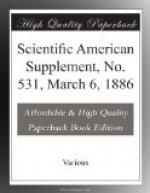Another substance produced from the Aspergillus rice is the soja sauce. The soja leaves, which contain little starch, but a great deal of oil and casein, are boiled, mixed with roasted barley, and then with the greenish yellow conidia powder of the Aspergillus. After the mycelium has fructified, the mass is treated with a solution of sodium chloride, which kills the Aspergillus, another fungus, of the nature of a Chalaza, and similar to that produced in the fermentation of “sauerkraut,” appearing in its place. The dark-brown soja sauce then separates.
* * * * *
ALUMINUM.
[Footnote: Annual address delivered by President J.A. Price before the meeting of the Scranton Board of Trade, Monday, January 18, 1886.]
By J.A. PRICE.
Iron is the basis of our civilization. Its supremacy and power it is impossible to overestimate; it enters every avenue of development, and it may be set down as the prime factor in the world’s progress. Its utility and its universality are hand in hand, whether in the magnificent iron steamship of the ocean, the network of iron rail upon land, the electric gossamer of the air, or in the most insignificant articles of building, of clothing, and of convenience. Without it, we should have miserably failed to reach our present exalted station, and the earth would scarcely maintain its present population; it is indeed the substance of substances. It is the Archimedean lever by which the great human world has been raised. Should it for a moment forget its cunning and lose its power, earthquake shocks or the wreck of matter could not be more disastrous. However axiomatic may be everything that can be said of this wonderful metal, it is undoubtedly certain that it must give way to a metal that has still greater proportions and vaster possibilities. Strange and startling as may seem the assertion, yet I believe it nevertheless to be true that we are approaching the period, if not already standing upon the threshold of the day, when this magical element will be radically supplanted, and when this valuable mineral will be as completely superseded as the stone of the aborigines. With all its apparent potency, it has its evident weaknesses; moisture is everywhere at war with it, gases and temperature destroy its fiber and its life, continued blows or motion crystallize and rob it of its strength, and acids will devour it in a night. If it be possible to eliminate all, or even one or more, of these qualities of weakness in any metal, still preserving both quantity and quality, that metal will be the metal of the future.




